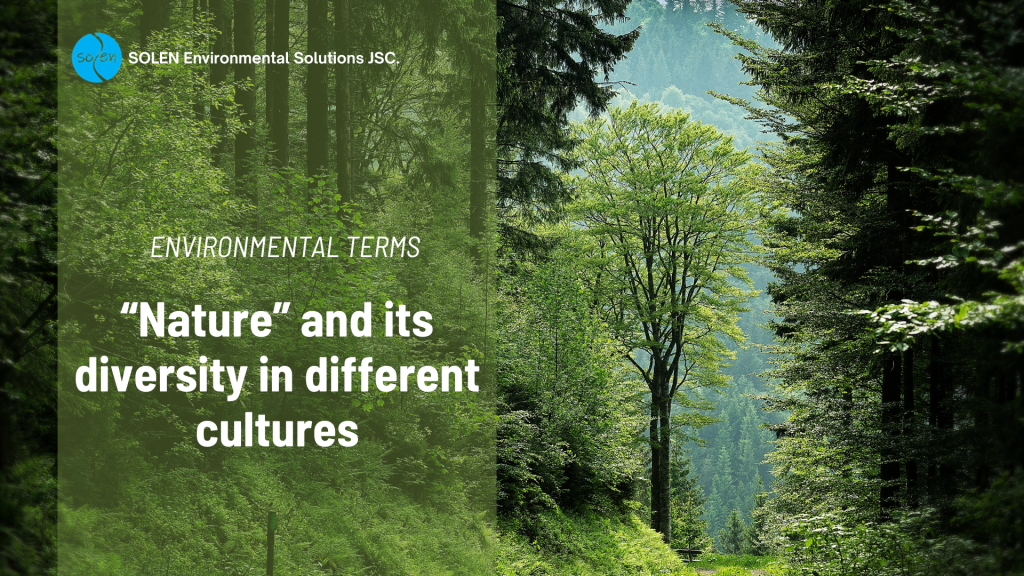I. What is “Nature”?
– In the broadest sense, nature is the physical world or universe. “Nature” can refer to the phenomena of the physical world, and also to life in general. The study of nature is a large, if not the only, part of science. Although humans are part of nature, human activity is often understood as a separate category from other natural phenomena;
– Within the various uses of the word today, “nature” often refers to geology and wildlife. Nature can refer to the general realm of living plants and animals and in some cases to the processes associated with inanimate objects—the way that particular types of things exist and change of their own accord, such as the weather and geology of the Earth. It is often taken to mean the “natural environment” or wilderness—wild animals, rocks, forest, and in general those things that have not been substantially altered by human intervention, or which persist despite human intervention. For example, manufactured objects and human interaction generally are not considered part of nature, unless qualified as, for example, “human nature” or “the whole of nature”. This more traditional concept of natural things that can still be found today implies a distinction between the natural and the artificial, with the artificial being understood as being brought into being by a human consciousness or a human mind. The term “natural” might also be distinguished from the unnatural or the supernatural depending on the particular context. [1]
II. “Nature” and its diversity in different cultures
– Among the key results, recently published in the scientific journal Environmental Science and Policy, are that “nature” can have very different meanings; might (or might not) include us, humans, within it; and may assume a spiritual connotation:
- In Western culture, we tend to refer to “nature” as a pristine element where human activities are mostly harmful, a violation of the natural order, or—on the other hand—when total control over nature is the only possible way for humans to thrive.
- More inclusive understandings of nature are embedded in other languages—for example, in the Japanese word [Sato-yama], which refers to landscapes where mutually beneficial relationships exist between nature and people.
- Other cultures, and most indigenous people, hold a more spiritual and holistic understanding of nature—Vasudha (Bengali Hindi), or Pachamama (Quechua and Aymara), the Mother Earth. This spiritual relation is inspiring most, though not all, of the movements granting legal rights to nature, entitling nature as a collective subject of interest, such as the Bolivian Law of Mother Earth. [2]
III. “Nature” and in East and South-East Asia cultures
– Nowadays, the term zìrán自然 is almost a fixed translation in modern Chinese of the environmental aspect of the English word “natural”. The ancient Chinese did not have proper nouns to denote the nature of the environment that excluded humans. Instead, it tends to directly name things in the environment, such as streams (川), lakes (淵), forests and mountains (山林), etc.; [3]
– For most Japanese people today, shizen自然 probably evokes lush green forests and mountains. Besides, the view of the nature of the Ainu indigenous people in northern Japan (Hokkaidō) was influenced by their hunting lifestyle, while the Ryukyu people in the area southern region of Japan (Okinawa) are centred on ancestral beliefs. at sea;
– There are two main words in Vietnamese used to refer to “nature”: Nature and Natural. The first word is most widely used in Vietnamese today with the meaning of nature as in the natural environment. It is etymologically derived from a combination of Chinese characters (tiānrán天然) including the character for the sky (tiān天) and the second character (rôn然) of the Chinese word for nature “zìrán” (自然). It includes animals, plants, and the land/water/air environment where animals and plants live. [4]
[REFERENCES]
- Nature. Extracted by: https://en.wikipedia.org/wiki/Nature [ONLINE]
- Layna Droz, Hsun-Mei Chen, Hung-Tao Chu, Rika Fajrini, Jerry Imbong, Romaric Jannel, Orika Komatsubara, Concordia Marie A. Lagasca-Hiloma, Chansatya Meas, Duy Hung Nguyen, Tshering Ongmu Sherpa, San Tun & Batkhuyag Undrakh. “Exploring the diversity of conceptualizations of nature in East and South-East Asia”. (2022). Humanities and Social Sciences Communications;
- Dao Duy A. (2005). Chinese-Vietnamese Dictionary. Culture and Information Publisher, 43 Lo Duc Street, Hanoi, Vietnam.
- Trinity College Dublin. “Global study unearths myriad meanings for ‘nature’ in different cultures”. (2019). Extracted by: News & Events Trinity College Dublin (tcd. ie)



 Tiếng Việt
Tiếng Việt 日本語
日本語